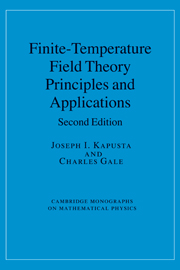Book contents
- Frontmatter
- Contents
- Preface
- 1 Review of quantum statistical mechanics
- 2 Functional integral representation of the partition function
- 3 Interactions and diagrammatic techniques
- 4 Renormalization
- 5 Quantum electrodynamics
- 6 Linear response theory
- 7 Spontaneous symmetry breaking and restoration
- 8 Quantum chromodynamics
- 9 Resummation and hard thermal loops
- 10 Lattice gauge theory
- 11 Dense nuclear matter
- 12 Hot hadronic matter
- 13 Nucleation theory
- 14 Heavy ion collisions
- 15 Weak interactions
- 16 Astrophysics and cosmology
- Conclusion
- Appendix
- Index
16 - Astrophysics and cosmology
Published online by Cambridge University Press: 04 November 2009
- Frontmatter
- Contents
- Preface
- 1 Review of quantum statistical mechanics
- 2 Functional integral representation of the partition function
- 3 Interactions and diagrammatic techniques
- 4 Renormalization
- 5 Quantum electrodynamics
- 6 Linear response theory
- 7 Spontaneous symmetry breaking and restoration
- 8 Quantum chromodynamics
- 9 Resummation and hard thermal loops
- 10 Lattice gauge theory
- 11 Dense nuclear matter
- 12 Hot hadronic matter
- 13 Nucleation theory
- 14 Heavy ion collisions
- 15 Weak interactions
- 16 Astrophysics and cosmology
- Conclusion
- Appendix
- Index
Summary
Finite-temperature field theory finds extensive applications in astrophysical environments and cosmology. This chapter is devoted to an introduction to these applications. A more comprehensive discussion could easily fill whole books.
The end product of the evolution of any star is a white dwarf star, a neutron star, or a black hole, depending on the initial mass of the star. A white dwarf star is held up against gravitational contraction by electron degeneracy pressure (Section 16.1) whereas a neutron star is held up by baryon degeneracy pressure and repulsive baryon interactions (Section 16.2). The sun will end its days by swelling up into a red giant and then collapsing to a white dwarf. Neutron stars are formed in the gravitational collapse of stars with initial mass in the range from about two to eight solar masses. The collapse is sudden and may be seen as a supernova. The resulting star is initially quite warm, perhaps 10 to 40 MeV in temperature, but cools rapidly by neutrino emission (Section 16.3). If the initial mass of the dying star is too great then it will end as a black hole.
There was some excitement when it was realized that a first-order QCD phase transition about one microsecond after the big bang could influence the abundances of the light isotopes such as deuterium, helium, and lithium. However, quantitative calculations now show that this is very unlikely (Section 16.4); in addition QCD, with its known set of quark masses, probably does not undergo a first-order phase transition, as we saw in Chapter 10.
- Type
- Chapter
- Information
- Finite-Temperature Field TheoryPrinciples and Applications, pp. 379 - 412Publisher: Cambridge University PressPrint publication year: 2006



